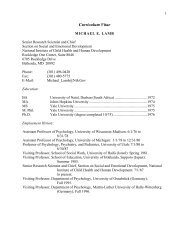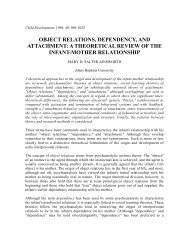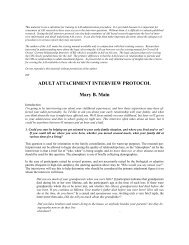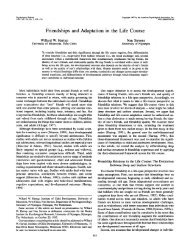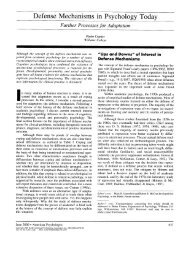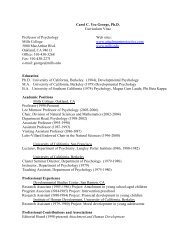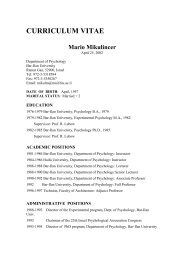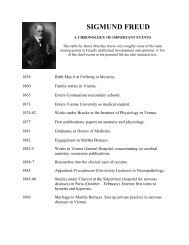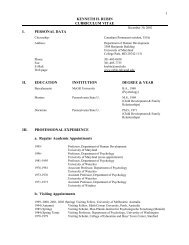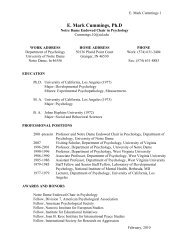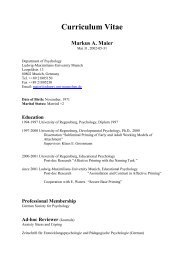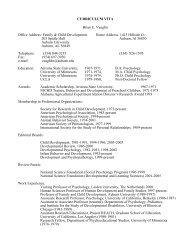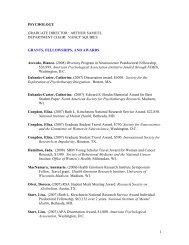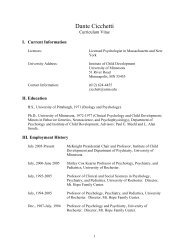the origins of attachment theory: john bowlby and mary ainsworth ...
the origins of attachment theory: john bowlby and mary ainsworth ...
the origins of attachment theory: john bowlby and mary ainsworth ...
You also want an ePaper? Increase the reach of your titles
YUMPU automatically turns print PDFs into web optimized ePapers that Google loves.
ment behavior is made up <strong>of</strong> a number <strong>of</strong> component instinctual responses that have <strong>the</strong> function<br />
<strong>of</strong> binding <strong>the</strong> infant to <strong>the</strong> mo<strong>the</strong>r <strong>and</strong> <strong>the</strong> mo<strong>the</strong>r to <strong>the</strong> infant. These component responses<br />
(among <strong>the</strong>m sucking, clinging, <strong>and</strong> following, as well as <strong>the</strong> signaling behaviors <strong>of</strong> smiling <strong>and</strong><br />
crying) mature relatively independently during <strong>the</strong> first year <strong>of</strong> life <strong>and</strong> become increasingly<br />
integrated <strong>and</strong> focused on a mo<strong>the</strong>r figure during <strong>the</strong> second 6 months. Bowlby saw clinging <strong>and</strong><br />
following as possibly more important for <strong>attachment</strong> than sucking <strong>and</strong> crying.<br />
To buttress his arguments, Bowlby reviewed data from existing empirical studies <strong>of</strong> infants’<br />
cognitive <strong>and</strong> social development, including those <strong>of</strong> Piaget (1951, 1954), with whose ideas he<br />
had become acquainted during a series <strong>of</strong> meetings by <strong>the</strong> ‘Psychobiology <strong>of</strong> <strong>the</strong> Child” study<br />
group, organized by <strong>the</strong> same Ronald I Hargreaves at <strong>the</strong> World Health Organization who had<br />
commissioned Bowlby’s 1951 report. These informative meetings, also attended by Erik Erikson,<br />
Julian Huxley, Baerbel Inhelder, Konrad Lorenz, Margaret Mead, <strong>and</strong> Ludwig von Bertalanffy,<br />
took place between 1953 <strong>and</strong> 1956. (Proceedings were published by Tavistock Publications.) For<br />
additional evidence, Bowlby drew on many years <strong>of</strong> experience as weekly facilitator <strong>of</strong> a support<br />
group for young mo<strong>the</strong>rs in London.<br />
After his careful discussion <strong>of</strong> infant development, Bowlby introduced ethological concepts,<br />
such as sign stimuli or social releasers that “cause” specific responses to he activated <strong>and</strong> shut <strong>of</strong>f<br />
or terminated (see Tinbergen, 1951). These stimuli could he external or intrapsychic, an important<br />
point in view <strong>of</strong> <strong>the</strong> fact that some psychoanalysts accused Bowlby <strong>of</strong> behaviorism because he<br />
supposedly ignored mental phenomena. Bowlby also took great pains to draw a clear distinction<br />
between <strong>the</strong> old social learning <strong>the</strong>ory concept <strong>of</strong> dependency <strong>and</strong> <strong>the</strong> new concept <strong>of</strong> <strong>attachment</strong>,<br />
noting that <strong>attachment</strong> is not indicative <strong>of</strong> regression, hut ra<strong>the</strong>r performs a natural, healthy<br />
function even in adult life.<br />
Bowlby’s new instinct <strong>the</strong>ory raised quite a storm at <strong>the</strong> British Psychoanalytic Society.<br />
Even Bowlby’s own analyst, Joan Riviere, protested. Anna Freud, who missed <strong>the</strong> meeting but<br />
read <strong>the</strong> paper, politely wrote:<br />
“Dr. Bowlby is too valuable a person to get lost to psychoanalysis” (Grosskurth, 1987).<br />
Separation Anxiety



